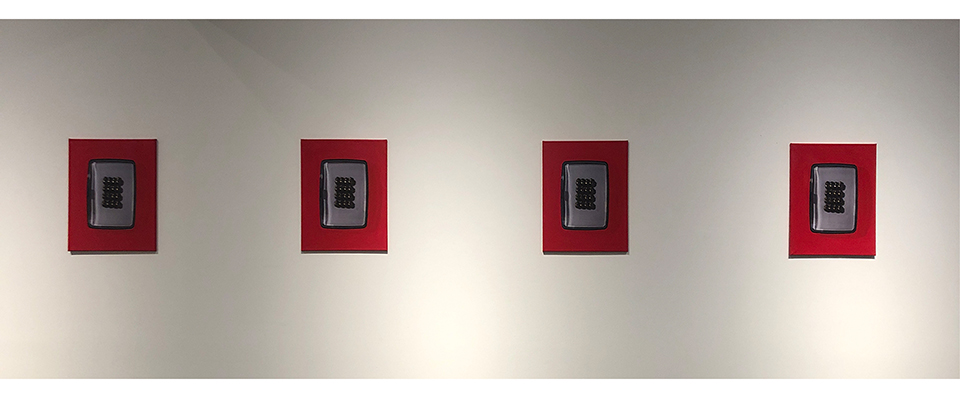신정재 개인전 시뮬라크르
신정재
2020 04/01 – 04/20
3 전시장 (3F)
허구의 탐색… 그리고 실재..
평생을 쫒았던 것들의 실재가 ‘존재’이냐 ‘허구’이냐는 이제 중요치 않을 듯싶다. 스스로가 열망했던 것들에 대한 도취는 그것의 실재 ‘보임’이 아닌 내 스스로를 존재시키기 위한 가제일 뿐. 나를 지탱해주는 명료한 힘. 그것이 중요하기 때문이다.
“동종배열한 오브제의 사열을 통한 사도마조히즘의 환상성”에 대해 생각해왔던 작가에게 “공간 안에 갇힌 실재의 연속”은 끊임없는 나르시즘과 환상, 도취적인 분위기로도 가득하다. taxonomy라는 분류에 의거된 동일한 피사체들의 반복은 퍼포먼스의 ‘실재’를 갖추고 대상들의 완벽한 외모 속에서 끊임없는 욕망을 탐미한다. 이들의 반복이란 어떠한가. 마치 스트로보스코프 현상(stroboscope image)처럼 ‘실체’(substance)로부터의 허구된 ‘연속’은 그것을 닮으려는 복제(copy)의 이미지로 충분하기 때문이다. 왜냐면 이 모든 것들이 ‘채집‘이란 퍼포먼스로 내 영원성에 기준하기 때문이다.
The excitement and pleasure of looking and obsessing over objects you have wanted may be explained more explicitly by psychoanalysis or psychology rather than by an aesthetic approach. However, this study artistically reveals that the fantasy of sorting and arranging the same collection and its visual-perceptual cognition can be explained from the aesthetic perspective of the human ‘eye’, and the fact that the human desire to collect could be explained by certain terms in psychology, through the mental frame based on that process.
All objects in the world have been ‘defined’ within the reasonable composition of individual existence. Therefore, the ‘individual definition’ based on human standards has been materialized by the rational insights of humans based on objective feasibility and it is only valuable from the perspective of taxonomy. This study declares that the background of human desire to ‘possess’ is the concept of ‘collection’ based on nomadism to prove that the ‘wholesomeness of objects’ is solely based on the ‘selfish possession’ of oneself. Moreover, this study explains the artistic semantics of the essence of ‘internal/external meaning’ of taxonomy in terms of ‘domination and subordination.’
This suggests that the factors that create human desires are also in the internal factors of objects as well as in the external factors to prove how the systemization of groups lead to the desire to collect using the concepts of art studies to represent that it has been a natural human act and an essential instinct that has been indispensable since ancient time. However, as collection has been used as a tool for authority, or a dictator’s ‘realization of desire,’ and the objects have been materialized and abused for mental and material systemization, the ‘structuralization of human powers’ has fallen into a ‘formative tool’ and makes us question their basic identity in terms of restriction. Therefore, the attempt to expand the formative desire of this study that began with collection from
biological taxonomy’ and military ‘inspect’ to ‘groups from individuals’ relates the observer’s desire to possess philosophical concepts based on visual perception. By doing so, it suggests an opportunity to discuss their ‘existential perpetuity’ based on the kinetic arts of lines for the arrangement of the same kind. Here exists the particularity of military aesthetics developed by the Otaku-like view of post-modernism and the formative advancement of the objects with the kinds of characters that can represent the development of mechanism. This observes the matrix of organizations from the maniacal perspective to master a certain area through immersion to focus on the aesthetic of systemized industrialization. Therefore, the eyes of the possessor confines the objects within the rectangular frames to master the new species generated from the diversity of derivation through the maniacal empire of the same kind to define the same aesthetics of formative desire and it is explained through time that the extrinsic value of the objects that are delivered from their static dynamics to a reality of overlapping is the only infinite possession that challenges the limit of death. This means that the process of developing classification is the act of possession through suppression and manifestation.
The act of possession, or, the desire to collect, achieves the outcome as the sadistic desire of the observer harmonizes the materialized passive system of masochism through coercive objects. Here, the organization of communities industrialized by the evolution of organisms and their infinite quantities are arranged with time to imply that the objects are perpetuated within a mass-production system. This joins the group of perpetual life along with the transience of life through the ongoing formative desire built on the collection and domestication of objects to urge the intervention of time by arrangement. Therefore, the place isolated from the control of space is where the possession of qualified objects is appreciated and this discussion suggests how the authority is arranged by artistic desire. This creates the possession of objects through taxonomy that submits to coerciveness, and converts sadomasochist acts into future effects through realization of infinite duplication. Here exists the industrialized ‘merging’ of prototypes derived from the biological holotype as well as the military aspects of objects which are connected to time in order to manifest how perpetual life is realized in a simulacrum realm through the arrangement of formative desire. This is the agony of life in terms of possession, the geometric peace calculated by visual-perceptive composure composed of the same kind, and affection for existence in the limitation of reality.





